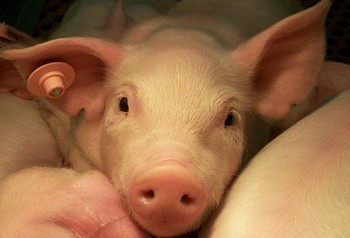Antimicrobial Enzyme Examined
Published: May 13, 2015
By: Jan Suszkiw, Agricultural Research Service Information Staff (USDA)
In 1921, Alexander Fleming discovered the antimicrobial powers of the enzyme lysozyme after observing diminished bacterial growth in a Petri dish where a drop from his runny nose had fallen. The famed Scottish bacteriologist published his findings a year later, but ultimately decided that the enzyme didn’t meet his criteria for a useful antibiotic—unlike penicillin, a later discovery.
Lysozyme, Fleming showed, is produced naturally in mucus, saliva, tears, and other bodily fluids of humans and other animals. Today, lysozyme from chicken egg whites is used in many food and beverage applications, notably wine- and cheese-making processes. Now, findings by Agricultural Research Service scientists suggest that lysozyme can also serve as a natural alternative to antibiotics used to improve feed efficiency and growth in pigs.

Their research, published in the October 2014 Journal of Animal Science, coincides with ongoing debate over whether using antibiotics in this manner contributes to the emergence of resistant strains of bacteria, threatening the compounds’ availability and effectiveness as infection-fighters in both veterinary and human medicine. According to the Centers for Disease Control and Prevention, antibiotic-resistant bacteria sicken more than 2 million people in the United States each year and cause the deaths of over 23,000 people directly.
“Swine producers are currently under pressure to eliminate subtherapeutic antibiotic use throughout the production cycle,” notes William Oliver, a physiologist at ARS’s U.S. Meat Animal Research Center in Clay Center, Nebraska. “Finding safe and effective alternatives to traditional antibiotics will give swine producers viable options in the event that removal of traditional antibiotics is needed.”
Oliver, together with ARS and university colleagues, began investigating lysozyme in 2010. In the most recently published trial, conducted at Clay Center, they compared growth rates and weight gains of 2 groups of 600 piglets placed on 1 of 3 diet regimens: a standard feed regimen of corn/soybean meal and specialty protein, a second regimen with lysozyme added, and a third containing the antibiotics chlortetracycline and tiamulin hydrogen fumarate.
The groups were also kept in weaning pens that had either been disinfected or left uncleaned since the last group of animals had occupied them. The latter was done to stimulate chronic, or long-term, immune activity, including the production of cytokines, which divert nutrients away from growth in swine and result in slower weight gain.
“We wanted to compare the effects of lysozyme and antibiotics when pigs had a chronic immune response,” explains Oliver, who collaborated with ARS microbiologist Jim Wells and University of Arkansas professor Charles Maxwell.
The results showed that piglets on lysozyme- or antibiotic-treated feeds grew approximately 12 percent faster than untreated pigs—even in uncleaned pens, suggesting that the treatments successfully ameliorated the effects of indirect immune challenge in the animals. Necropsies revealed intestinal differences between untreated and treated piglets. For example, lysozyme- or antibiotic-fed piglets had longer fingerlike projections called “villi,” which absorb nutrients from feed.
“The mechanism by which lysozyme and antibiotics increase growth and feed efficiency is not completely understood,” says Oliver. “We believe that a large part of it is due to improved gastrointestinal health. Changes in the animals’ gastrointestinal bacteria likely play a role also.”
Acknowledgement
This article was originally published in the U.S Department of Agriculture´s science magazine, Agricultural Research, May 2015. Engormix.com thanks for this contribution.
Source
Jan Suszkiw, Agricultural Research Service Information Staff (USDA)Related topics:
Authors:
Recommend
Comment
Share
Farmer Joe Group
20 de mayo de 2015
Why not publish the FULL RESULTS?
Have any trials been done with poultry?
I am always suspicious when people publish results in an incomplete or selective manner.
Do they have some secret agenda?
Recommend
Reply
Engormix
26 de mayo de 2015
Dear members,
You can have access to the full article (originally published at the Journal of Animal science) HERE.
Hope you enjoy the reading!
Best regards,
Recommend
Reply

Would you like to discuss another topic? Create a new post to engage with experts in the community.










